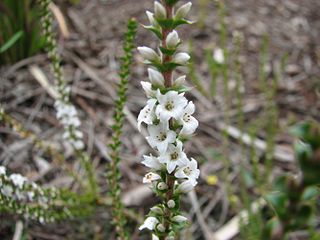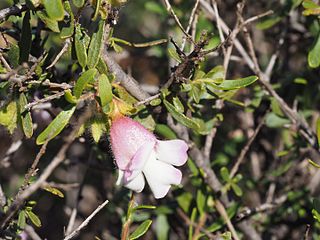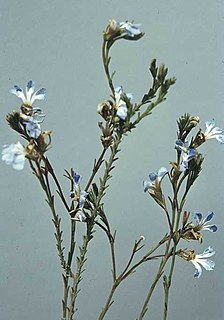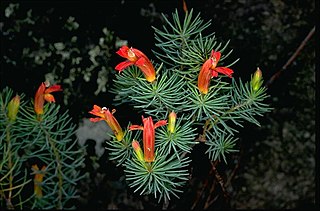
Ranunculus repens, the creeping buttercup, is a flowering plant in the buttercup family Ranunculaceae, native to Europe, Asia and northwestern Africa. It is also called creeping crowfoot and sitfast.

Ranunculus glaberrimus, the sagebrush buttercup, is a species of flowering plant in the buttercup family, Ranunculaceae. It is native to interior western North America, in western Canada, the western United States, and the northwestern Great Plains.

Grevillea acanthifolia, commonly known as the Acanthus-leaved grevillea, is a plant in the family Proteaceae and is endemic to New South Wales. It is a shrub with stiff, prickly, divided leaves and pink to purple "toothbrush" flowers.

Eremophila gibbifolia, commonly known as coccid emu-bush, is a flowering plant in the figwort family, Scrophulariaceae and is endemic to Australia. It is a small, rare shrub in the wild, found only in Victoria and South Australia. It has small, fleshy, lumpy leaves and lilac-coloured to purple flowers, spotted inside.

Epacris gunnii is a species of flowering plant in the family Ericaceae and is endemic to south-eastern Australia. It is an erect shrub with hairy branchlets, concave, sharply-pointed, broadly egg-shaped leaves, and tube-shaped, white flowers arranged along the stems.

Ranunculus parviflorus is a species of buttercup known by the common name smallflower buttercup. It is native to Europe, but it is known on other areas of the world as an introduced species and sometimes a roadside weed, for example, in parts of Australia and the United States.

Prostanthera walteri, commonly known as blotchy mint-bush, is a species of flowering plant that is endemic to south-eastern Australia. It is a sprawling shrub with tangled, hairy branches, egg-shaped leaves and usually bluish green flowers with prominent purple veins arranged singly in leaf axils.

Eremophila spinescens is a flowering plant in the figwort family, Scrophulariaceae and is endemic to Western Australia. It is a low, spreading, rigid, spiny shrub with small leaves and lilac to dark purple flowers.
Hibbertia marginata, commonly known as bordered guinea flower, is a species of flowering plant in the family Dilleniaceae and is endemic to the North Coast of New South Wales. It is a spreading shrub with hairy young branches, oblong to lance-shaped leaves and yellow flowers with thirty to forty stamens and many staminodes arranged around three hairy carpels.

Diuris aequalis, commonly called the buttercup doubletail, is a species of orchid which is endemic to New South Wales. It has two rolled leaves and spikes of two to five golden-yellow to orange flowers and is classified as "vulnerable".
Caladenia audasii is a plant in the orchid family Orchidaceae and is endemic to Victoria. It is a rare ground orchid with a single hairy leaf and a single yellow flower.

Pityrodia augustensis, commonly known as Mount Augustus foxglove, is a flowering plant in the mint family Lamiaceae and is endemic to a small area in Western Australia. It is a small, bushy shrub with its branches, leaves and some of its flower parts densely covered with woolly hairs. It is similar to the lovely foxglove and the sandplain foxglove but has very different leaves from those species.

Quoya dilatata is a flowering plant in the mint family Lamiaceae and is endemic to Western Australia. It is a low, spreading shrub with its branches and leaves densely covered with a layer of white, woolly hairs. The leaves are wrinkled or crinkly and the tube-shaped flowers are orange-red and hairy on the outside.

Pityrodia hemigenioides is a flowering plant in the mint family Lamiaceae and is endemic to the south-west of Western Australia. It is a spreading shrub with densely hairy branches and leaves, and pale white flowers near the ends of the branches.
Leionema hillebrandii, commonly known as Mount Lofty phebalium, is a perennial, woody shrub endemic to South Australia. It has variable shaped leaves and pinkish flowers from late winter to spring.
Hibbertia intermedia is a species of flowering plant in the family Dilleniaceae and is endemic to New South Wales. It is a small shrublet with linear to narrow oblong leaves and yellow flowers usually with seven to nine stamens arranged in a single cluster.
Hibbertia tenuifolia, commonly known as narrow-leaved guinea flower, is a species of flowering plant in the family Dilleniaceae and is endemic to eastern Australia. It is a small, spreading shrublet with hairy foliage, linear leaves and yellow flowers with twelve to sixteen stamens on one side of two carpels.

Lechenaultia heteromera, commonly known as claw leschenaultia, is a species of flowering plant in the family Goodeniaceae and is endemic to the south-west of Western Australia. It is a subshrub with a few wand-like branches, fleshy leaves, and white and pale blue flowers.

Lechenaultia longiloba, commonly named Irwin leschenaultia, is a species of flowering plant in the family Goodeniaceae and is endemic to the south-west of Western Australia. It is a straggling, low-lying herb or subshrub with narrow, rather fleshy leaves, and pale yellow or green petals with deep pink or red wings.

Lechenaultia superba, commonly known as Barrens leschenaultia, is a species of flowering plant in the family Goodeniaceae and is endemic to near-coastal areas of southern Western Australia. It is an erect, spreading shrub with crowded, narrow, fleshy leaves and yellow, red, or yellow and orange flowers.














